
How To Use Magento 2 Cart Price Rules for Dynamic Promotions?
Do your customers abandon their shopping cart contents before buying? Magento 2 cart price rules address this by targeting customer behaviors with precision. They create intelligent promotional systems through automated discounts.
This article explains how Magento’s cart rules target behavioral triggers. It shows how to set up your dynamic campaigns for the most revenue impact.
Key Takeaways
-
5 Magento cart price rule types create conditional promotions for customer segments.
-
Behavioral insights reduce the 26% cart abandonment rate due to complex checkouts.
-
Dynamic campaigns run without manual intervention once you set up new rules.
-
3 promotion layers stack together using priority settings to avoid discount conflicts.
-
Personalization targets customers based on shopping behavior to raise conversions.
What Are Cart Price Rules in Magento 2?
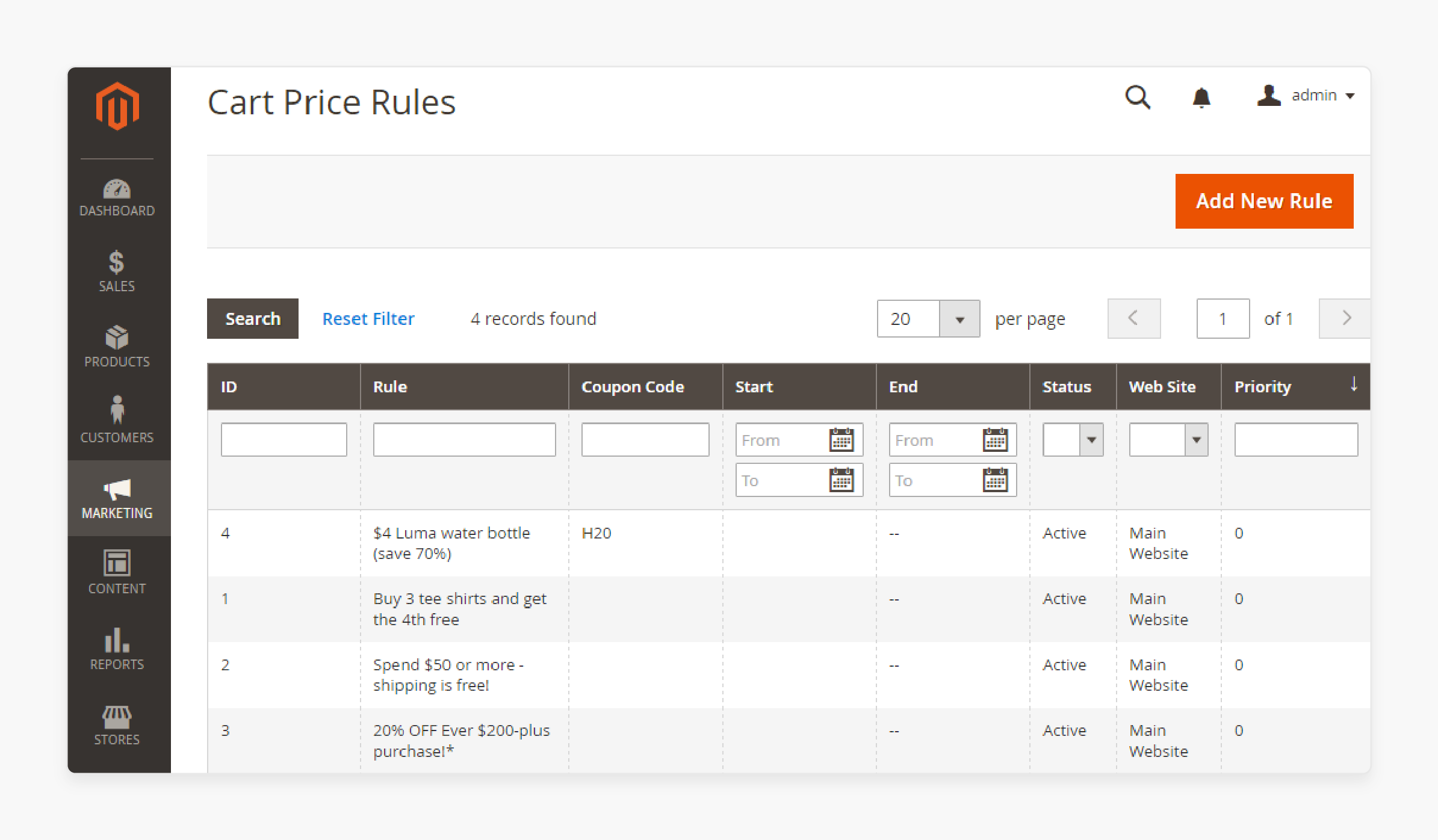
Magento 2 shopping cart price rules check customer data to determine applicable prices. They verify the contents of the cart during the checkout process.
The system processes rule conditions in real time. Rules apply the discount when the criteria match customer behavior.
The engine works through three components:
-
Condition Engine: Evaluates customer attributes and shopping cart data.
-
Action Processor: Executes the applicable percent of product price discount.
-
Priority Manager: Handles several rule interactions and conflicts.
Do Cart Price Rules Differ from Catalog Price Rules?
Yes. Here are the key differences:
| Feature | Cart Price Rules | Catalog Price Rules |
|---|---|---|
| Trigger Point | Checkout process | Product price display |
| Data Source | Shopping cart contents and customer behavior | Product attributes only |
| Personalization | Customer targeting | Original price modifications |
| Complexity | Multi-condition logic | Single attribute filters |
| Performance Impact | Checkout-exclusive processing | Site-wide product price calculations |
What Is the Role of Cart Price Rules in Magento 2’s Promotion System?
Cart price rules integrate with Magento 2’s core promotional systems:
-
Customer Segmentation API: Accesses behavioral data and buying history.
-
Inventory Management: Connects stock levels to campaign triggers.
-
Marketing Systems: Feeds data to email and retargeting campaigns.
-
Analytics Engine: Tracks rule performance and customer responses.
What Are the Key Components of Cart Price Rules?
1. Conditions vs. Actions Breakdown
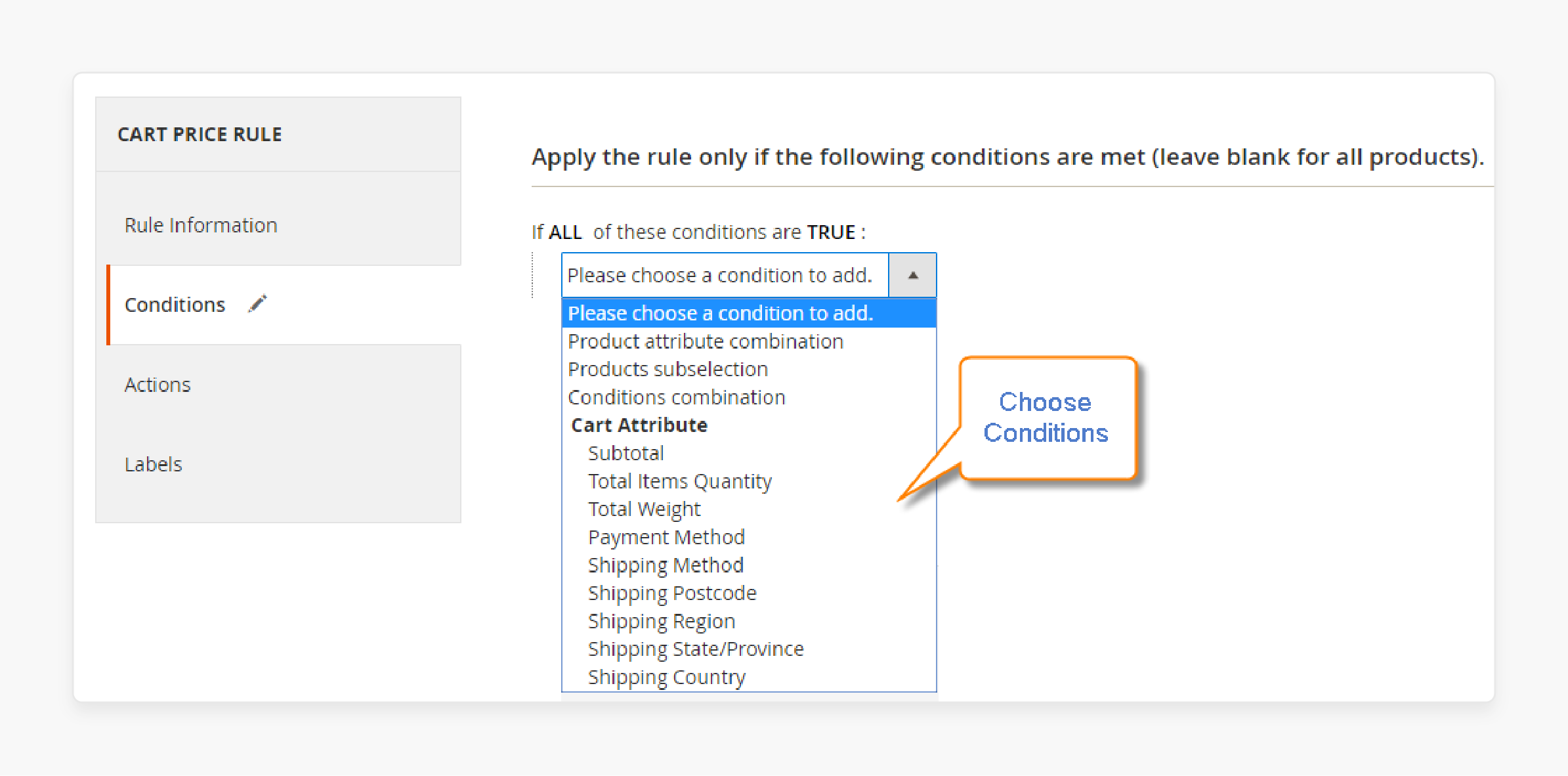
The cart price rule architecture follows conditional logic programming:
IF (Condition Set A AND Condition Set B)
THEN (Execute Action C WITH Constraints D)
Condition Types:
-
Customer Attributes: Segment, location, buying history, and registration date.
-
Cart Attributes: Subtotal, quantity, weight, and shipping method.
-
Product Attributes: Category, SKU, brand, and custom fields.
-
Time Attributes: Date ranges, day of week, and hour of day.
Action Categories:
-
Discount Calculations: Percentage, fixed amount, and buy x get y free formulas.
-
Shipping Modifications: No-charge shipping, reduced rates, and method restrictions.
-
Product Additions: Free items and suggested upsells.
-
Rule Processing: Discard subsequent rules and priority overrides.
2. Rule Priority and Stacking Mechanisms
Magento processes cart rules using a priority queue system:
-
Priority Assignment: Numeric values (1 = highest, 999 = lowest).
-
Sequential Processing: Rules execute in priority order.
-
Accumulation Logic: Discounts stack unless ‘stop processing’ activates.
-
Conflict Resolution: Higher-priority rules override lower-priority ones.
Priority Strategy Matrix:
| Priority Range | Use Case | Example |
|---|---|---|
| 1-99 | Critical business rules | VIP exclusive discounts |
| 100-199 | Seasonal campaigns | Holiday campaigns |
| 200-299 | Category promotions | Department clearances |
| 300-399 | General discounts | Site-wide percentage offs |
| 400-999 | Fallback rules | Shopping cart incentives |
3. Coupon Integration Options
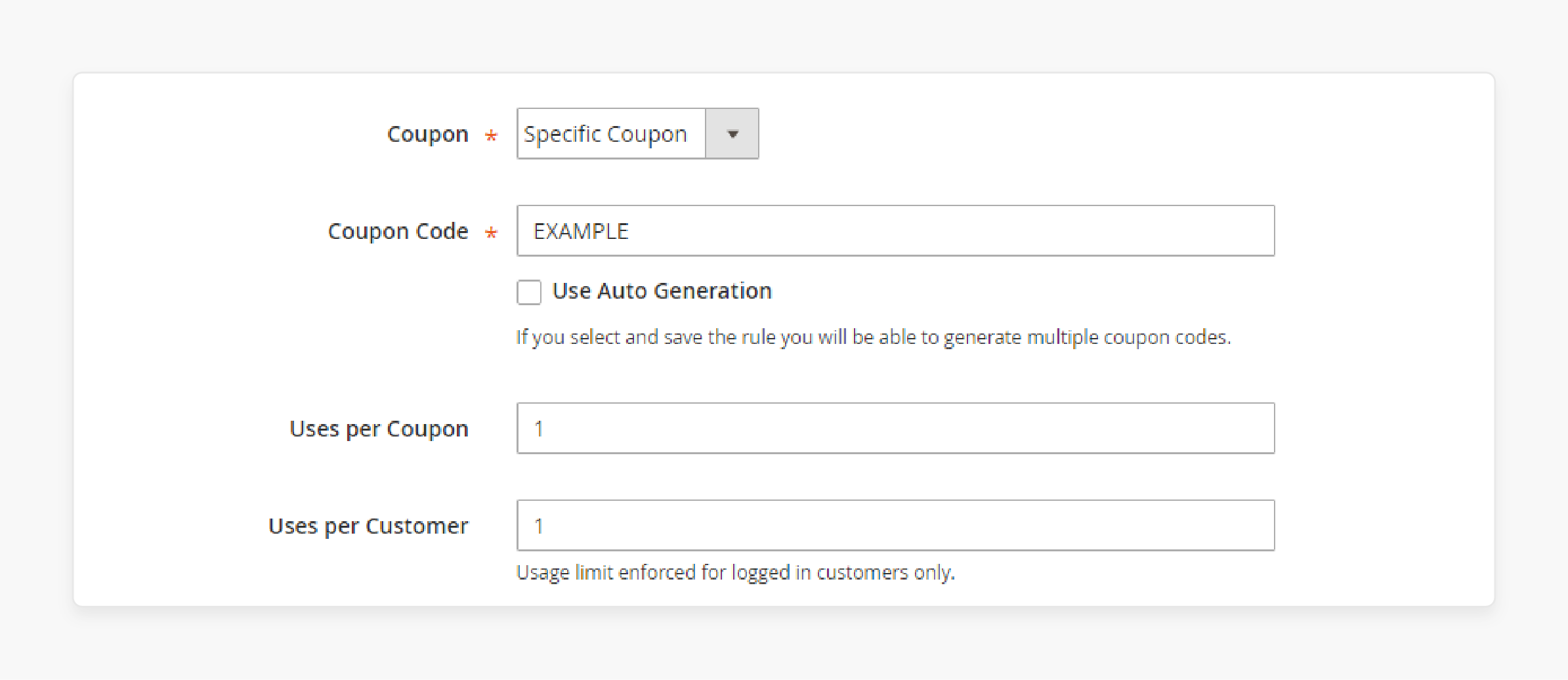
The Magento coupon code system operates through three modes:
Auto-Application Mode:
-
Rules activate without customer input.
-
Higher conversion rates due to friction reduction.
-
Limited campaign tracking.
Coupon-Required Mode:
-
The customer enters coupon codes for activation.
-
Better tracking and attribution.
-
Social sharing and referral opportunities.
Hybrid Mode:
-
Auto-application for VIP segments.
-
Coupon code rules for general customers.
-
Segmented campaign performance analysis.
How to Calculate the ROI of Cart Price Rules?
Here are the essential KPIs to track:
-
Conversion Rate Lift: (Post-Rule Conversion - Baseline) / Baseline × 100.
-
Revenue per Visitor: Impact measurement across customer segments.
-
Average Order Value: Changes before and after rule implementation.
-
Customer Lifetime Value: Impact from repeat purchase behavior.
ROI Calculation Framework:
[Revenue Increase - Discount Costs - Implementation Time = Net ROI]
-
Track these metrics monthly to optimize rule performance.
-
Calculate baseline metrics before launching new rules.
-
Compare performance across different customer segments for targeted improvements.
Why Use Magento’s Cart Price Rules for Dynamic Promotions?
Smart campaign strategies deliver measurable business improvements across key areas:
1. Conversion Rate Optimization
Rules target customer hesitations and objections. The system identifies patterns of shopping cart abandonment. Rules deploy appropriate incentives at decision moments.
Campaigns improve conversion rates compared to static discount strategies.
2. Customer Retention Benefits
Promotions create stronger customer relationships. The system remembers sale patterns and preferences. Rules adapt offers to individual customer value.
3. Competitive Advantage
Promotional responses outpace competitor reaction times. Rules adjust to market conditions. The system maintains profit margins during price wars.
4. Resource Management
Rules reduce the marketing team’s workload. Campaign setup time drops from hours to minutes. Teams can deploy rule modifications across all channels in real time.
5. Revenue Protection
Intelligent discount limits prevent margin erosion. Rules apply thresholds and discount caps. The system tracks promotional ROI.
5 Types of Magento Cart Price Rules for Dynamic Promotions
Different cart price rule types serve promotional strategies and customer segments.
1. Percentage-Based Discount Rules
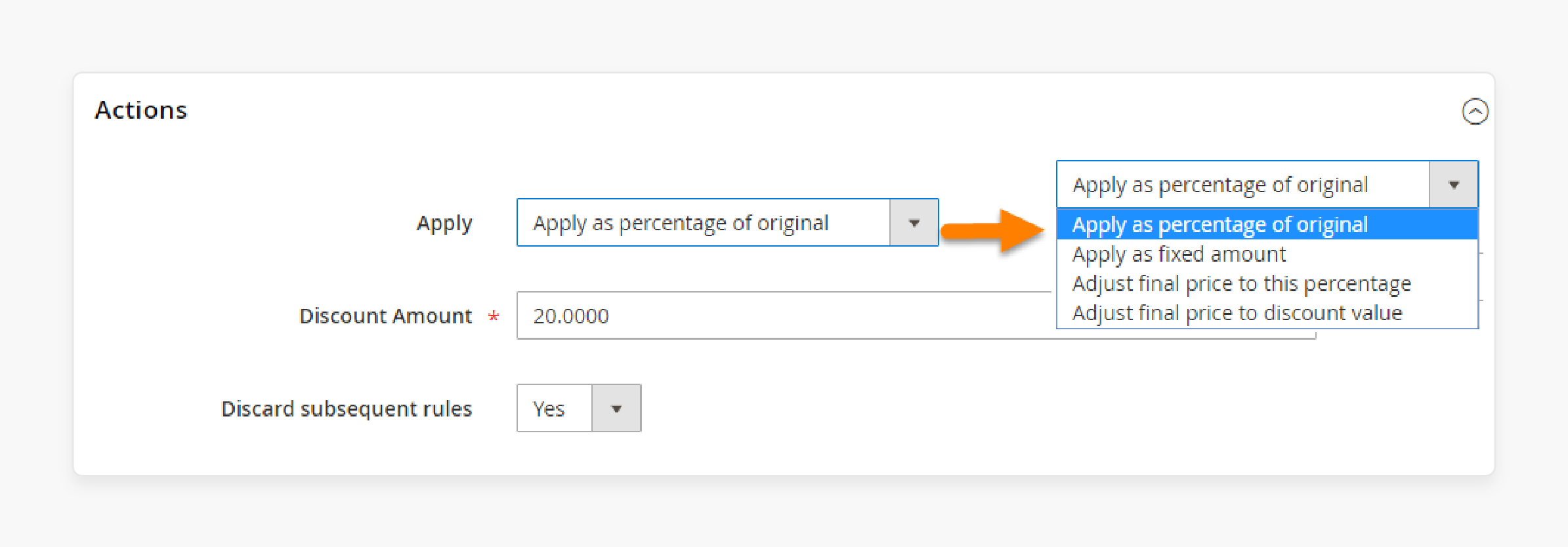
Fixed Percentage Discounts
Single percentage rates apply to qualifying shopping cart contents.
Examples:
-
Cart-wide: 15% off the entire sale total.
-
Category-based: 20% off the electronics category only.
-
Brand-focused: 25% off Nike products only.
Implementation Structure:
-
Condition: Product Category = Electronics.
-
Action: Apply a 20% discount to matching items.
-
Constraint: Discount up to $200 per order.
Tiered Percentage Promotions
Progressive discount structures reward larger sale quantities.
Examples:
| Cart Total | Discount Rate | Revenue Impact |
|---|---|---|
| $50-99 | 5% off | Entry-level incentive |
| $100-199 | 10% off | Sale incentive |
| $200-299 | 15% off | Upsell motivation |
| Over $300 | 20% off | Reward tier |
2. Fixed Amount Discount Rules
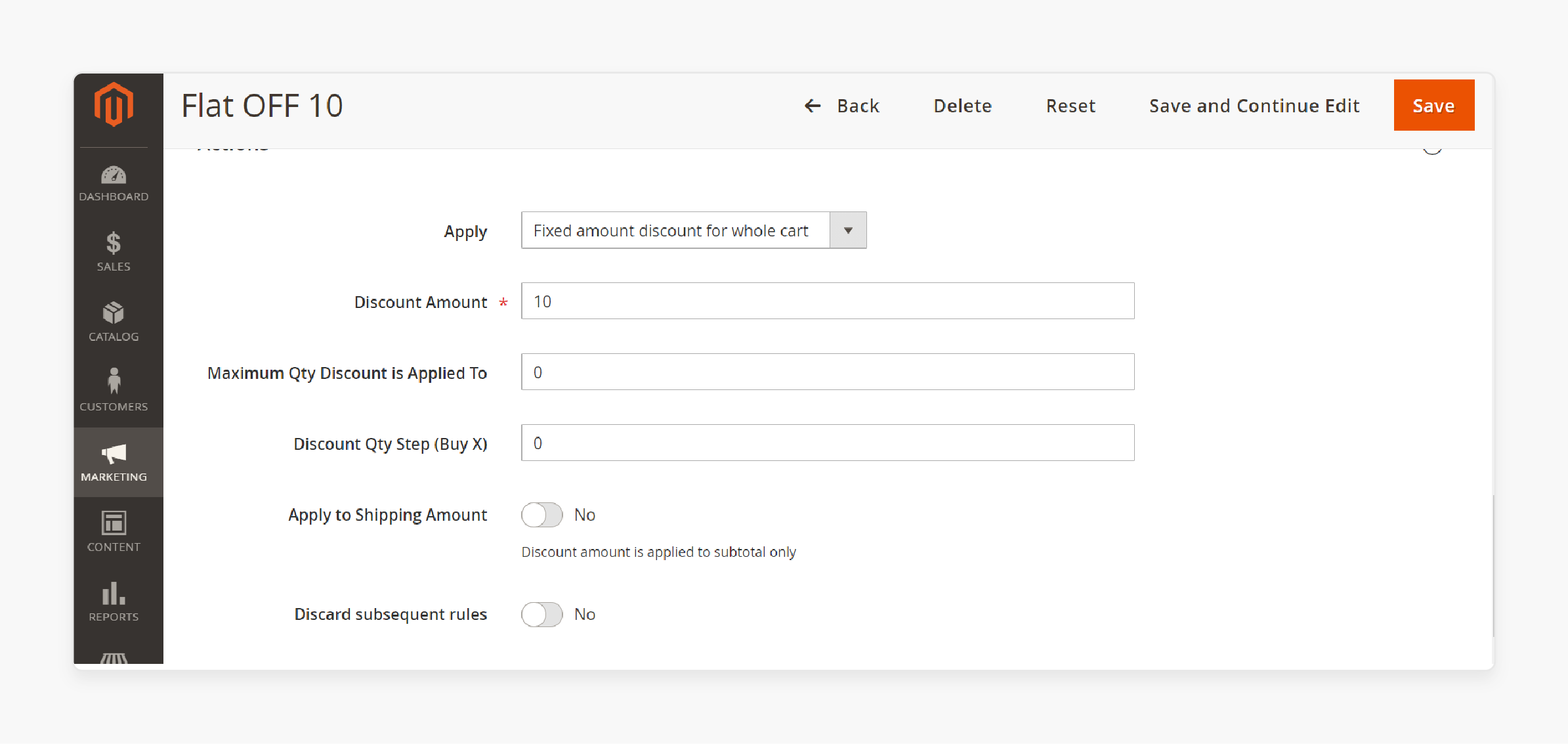
Cart-wide Fixed Discounts
Discount amount reductions target price points.
Examples:
-
$25 off orders over $150.
-
$50 off orders over $300.
-
$10 off any clearance items.
Per-item Fixed Discounts
Individual product discounts create buying momentum.
Examples:
-
$5 off each item when buying 3 or more.
-
$15 off each jacket in clearance.
-
$20 off accessories with apparel sale.
Strategic Implementation:
-
Condition: Cart contains more than 3 items from the Clearance category.
-
Action: Apply a $5 discount per clearance item.
-
Limit: 10 discounted items per order.
3. Buy X Get Y Free Promotions
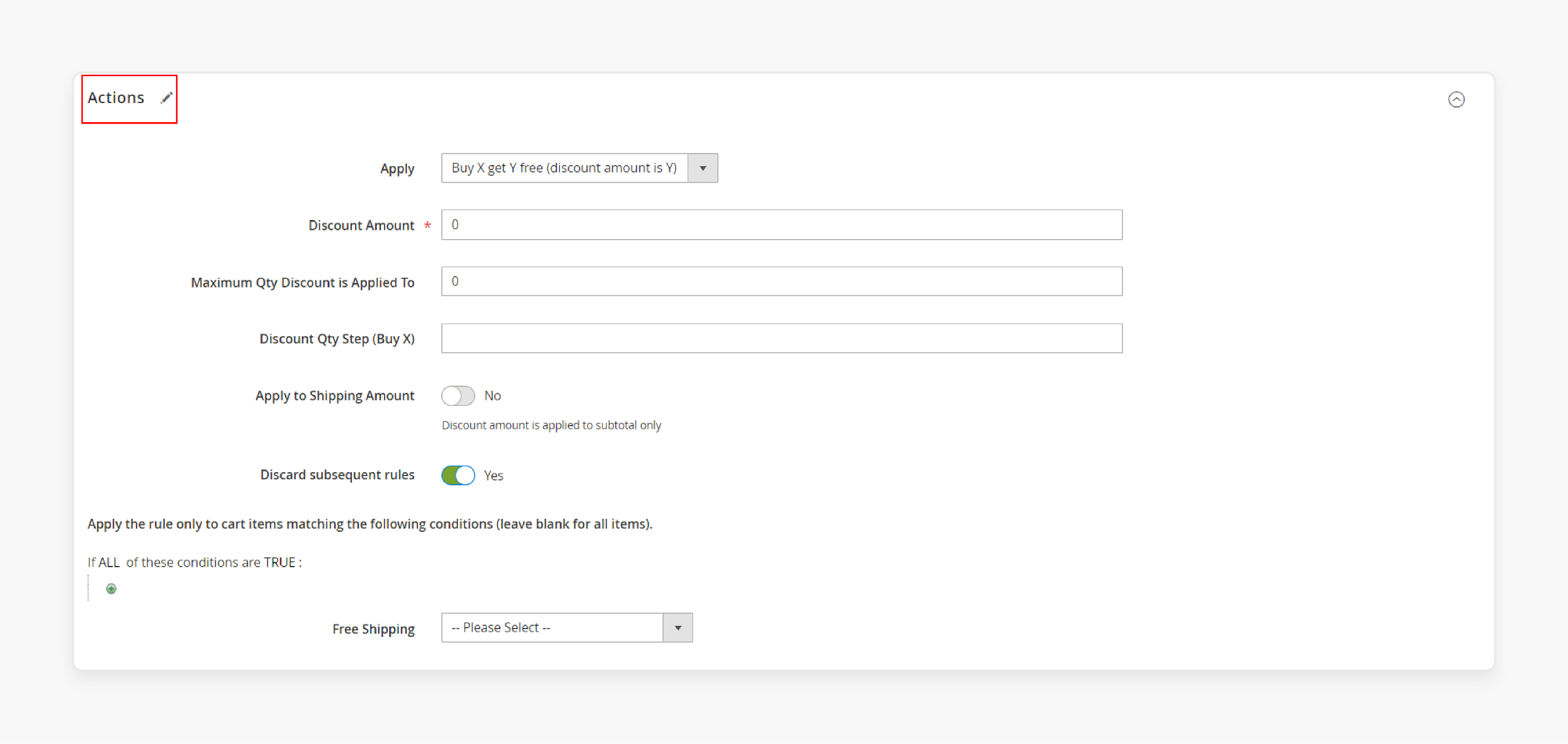
BOGO (Buy One Get One) Setups
Equal value free item promotions drive quantity increases.
Examples:
-
Same Product: Buy one, get a second jacket free.
-
Category Mix: Buy pants, get a belt free.
-
Value Tier: Buy premium items, get standard items free.
Quantity-based Free Item Rules:
-
3-for-2 Deals: Buy 3 shirts, get the cheapest free.
-
Mix and Match: Buy 4 items from any category and get the 5th one free.
-
Stepped Rewards: Buy 5, get 1 free; buy 10, get 3 free.
Advanced BOGO Logic Examples:
-
Condition: Cart contains more than 2 items from ‘Premium Jackets’.
-
Action: Add the cheapest qualifying jacket to the cart with a 100% discount.
-
Constraint: One free item per customer per day.
4. Free Shipping Rules
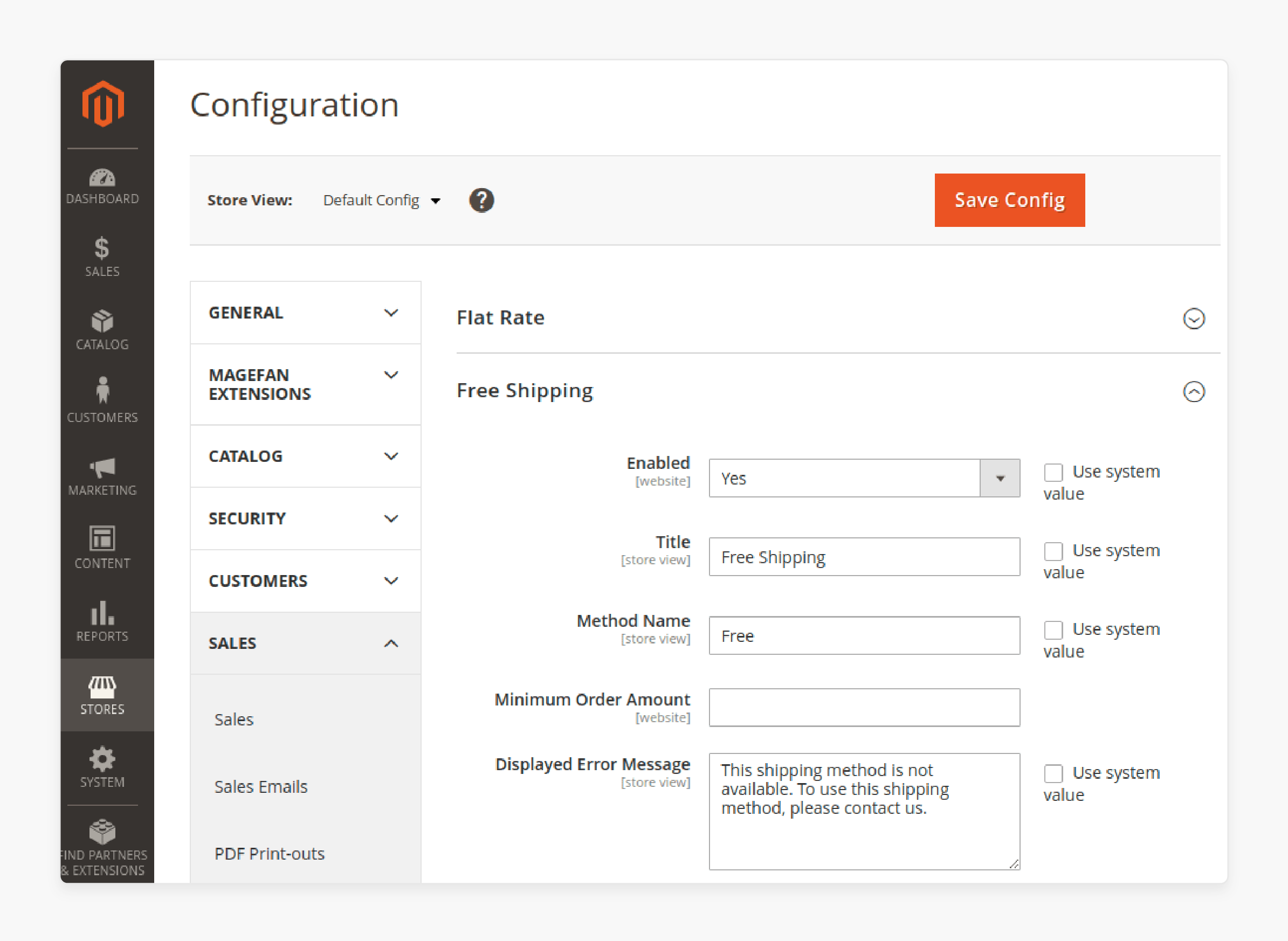
Order Value Triggers
Order value or customer status thresholds offer zero-charge shipping benefits.
Examples:
-
No shipping fee on orders over $75.
-
VIP customers get zero-charge shipping at $50.
-
No shipping costs within 50 miles of the warehouses.
Product Category Conditions
Targeted categories or sale quantities qualify for complimentary shipping.
Examples:
-
No shipping fees on furniture selling.
-
No shipping fees on orders of 6 or more books.
-
No shipping fees on holiday decorations.
Shipping Rule Architecture:
-
Condition A: Cart subtotal ≥ $75.
-
Condition B: Shipping destination = United States.
-
Action: Set shipping cost = $0 for standard delivery.
-
Override: Does not apply to expedited shipping options.
Geographic Targeting Examples:
-
Zero shipping fees within state boundaries.
-
Zero shipping fees, same-day delivery in major cities.
-
Zero shipping fees to Canada on orders over $200.
5. Advanced Conditional Promotions
Customer Group-based Rules
Segmented campaigns create exclusive experiences:
| Customer Segment | Discount Structure | Activation Trigger |
|---|---|---|
| New Customers | 15% first order | Account creation date <30 days |
| Exclusive Members | 25% exclusive access | Lifetime value >$1000 |
| Inactive Customers | 30% win-back offer | Last sale >90 days |
| Birthday Customers | $50 birthday gift | Birth month = current month |
Quarterly Promotion Planning Matrix
Strategic planning prevents promotional conflicts and maximizes seasonal opportunities:
| Customer Segment | Q1 Strategy | Expected Lift | Budget | KPIs |
|---|---|---|---|---|
| New Customers | 15% First Order Welcome | +25% Conversion | €5k | CAC, LTV |
| VIP Tier | Early Access Sales | +10% AOV | €3k | Retention Rate |
| Inactive Customers | Win-back 20% Discount | +15% Reactivation | €2k | Churn Reduction |
| Seasonal Shoppers | Holiday Bundle Deals | +30% Revenue | €8k | Peak Sales Volume |
Plan promotions 90 days in advance to coordinate inventory and marketing campaigns. Adjust budgets based on historical performance data for each customer segment.
Time-sensitive Flash Sales
Short-duration discounts create urgency and drive immediate sales.
Examples:
-
Hour-Based Pricing: Discounts decrease by the hour.
-
Day-of-week Specials: Tuesday, 20% off electronics.
-
Seasonal Triggers: Back-to-school 48-hour sale.
Flash Sale Technical Setup:
-
Condition: Current time between 2 PM and 4 PM EST.
-
More: Product category = Electronics.
-
Action: Apply a 30% discount.
-
Auto-disable: Rule deactivates at 4:01 PM EST.
Product Attribute-based Conditions
Attribute-driven campaigns reward the buying of specific product variants.
Examples:
-
Buy x red items, get 20% off on blue accessories.
-
XL/XXL items get an extra 10% off.
-
Buy x Nike shoes, get 15% off Adidas apparel.
6-Step Guide for Creating Cart Price Rules in Magento 2
Setting up cart price rules requires a systematic configuration and testing process.
Step 1: Access the Cart Price Rules Interface
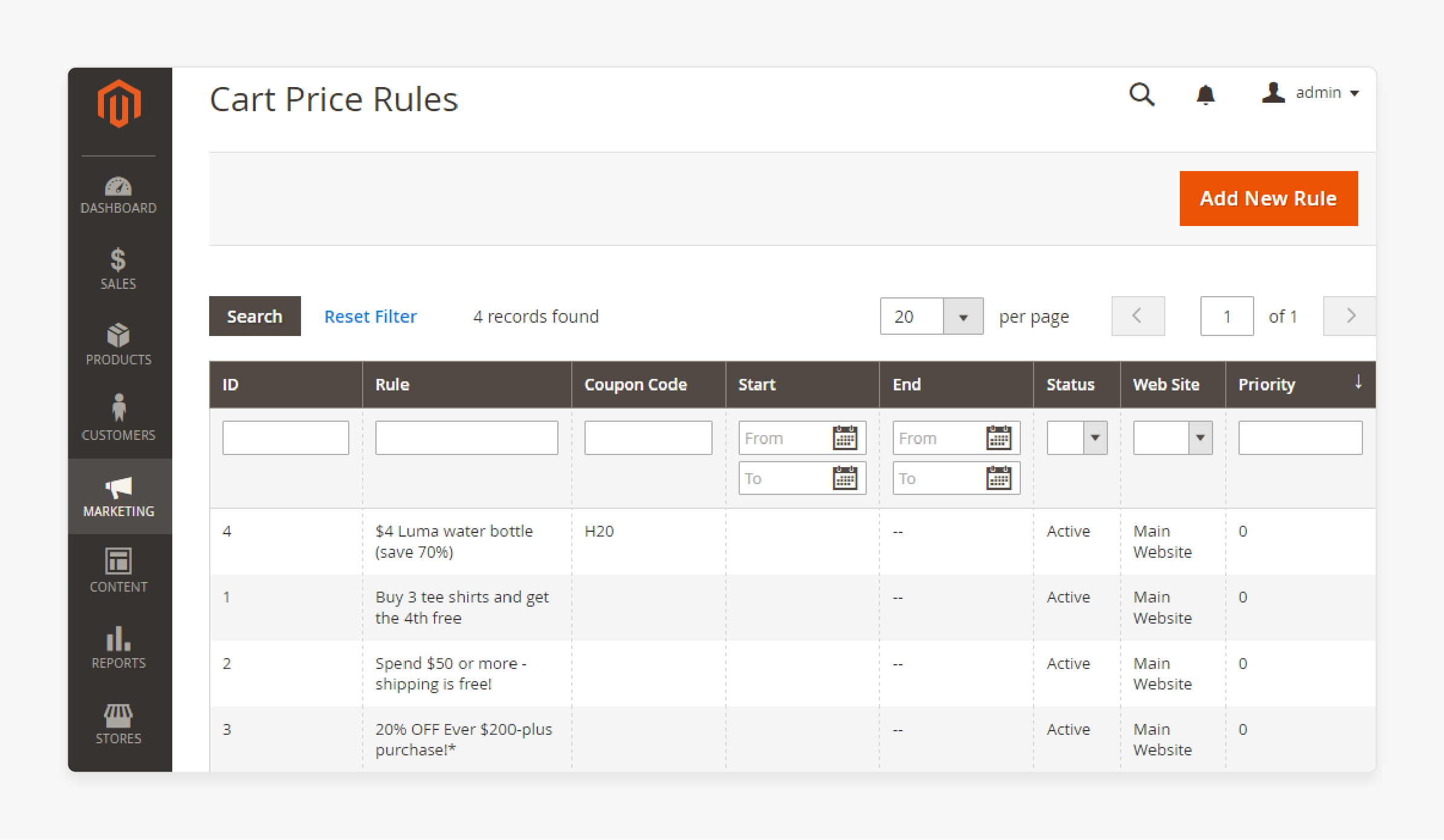
Navigation Path: Admin Panel → Marketing → Promotions → Cart Price Rules
Interface Components Analysis
| Section | Function | Key Features |
|---|---|---|
| Rules Grid | Display existing cart rules | Status, priority, dates, usage |
| Action Toolbar | Bulk operations | Enable/disable, delete, export |
| Filter Panel | Search functionality | Name, status, customer groups |
| Analytics Widget | Performance tracking | Conversion rates, revenue impact |
Initial Setup Requirements
-
User Permissions: Verify Marketing Manager Access Rights.
-
Store Configuration: Confirm multi-store settings and scope.
-
Cache Management: Clear promotional rule cache before testing.
Step 2: Configure Basic Rule Information
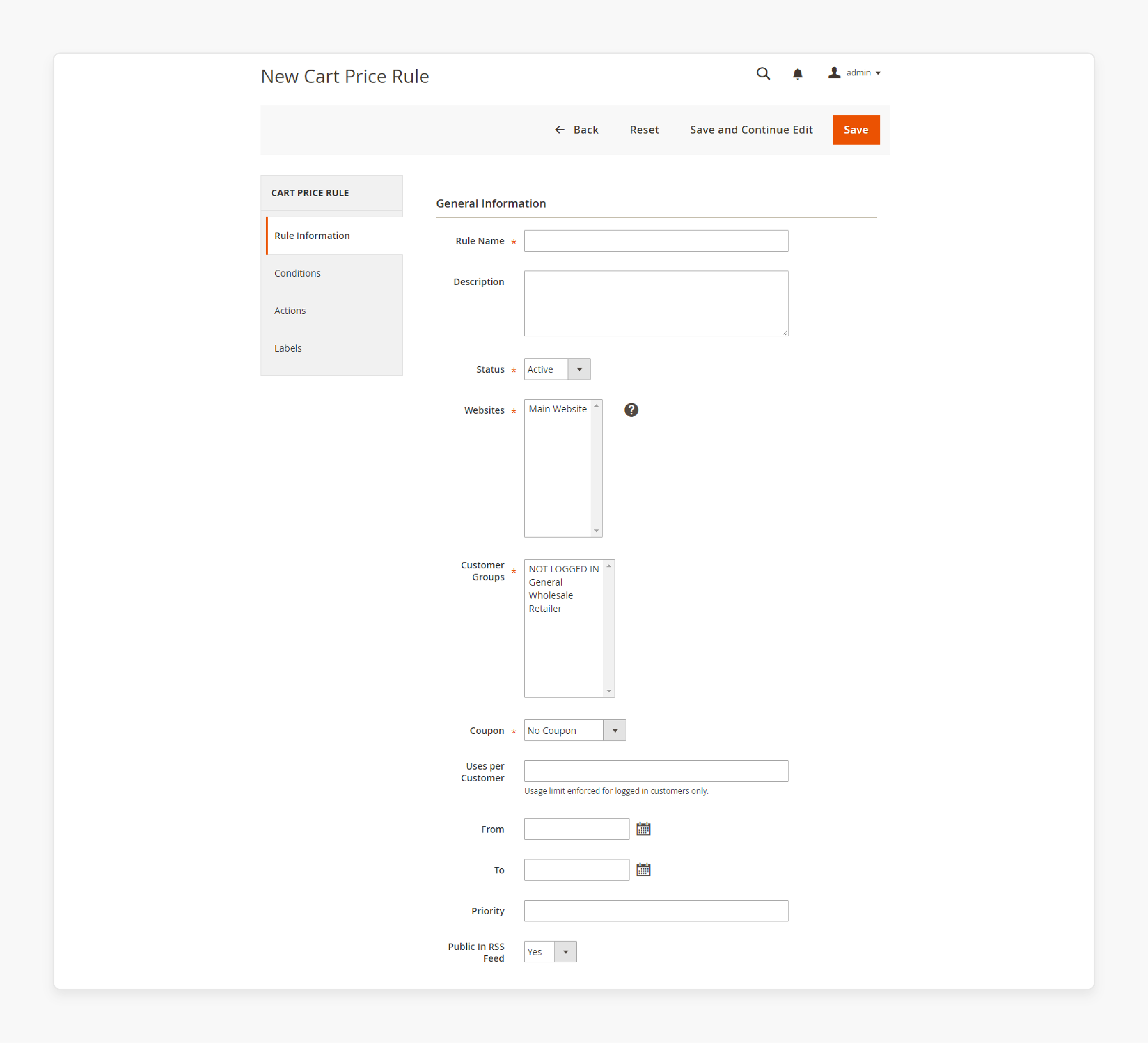
Rule Name and Description Standards
Naming conventions ensure organized cart price rule management:
Format: [YEAR]_[QUARTER]_[SEGMENT]_[TYPE]_[TRIGGER]
Examples:
- 2024_Q1_VIP_PERCENT_BIRTHDAY
- 2024_Q2_NEW_FIXED_WELCOME
- 2024_Q3_ALL_SHIPPING_THRESHOLD
Status and Priority Configuration
Priority assignment prevents cart price rule conflicts:
-
Testing Phase: Set status to Inactive for safe testing.
-
Priority Gaps: Use increments of 10 (10, 20, 30) for future insertions.
-
Documentation: Record priority logic in rule information.
Website and Customer Group Targeting
Multi-store deployment requires careful scope management:
Targeting Matrix:
Website A (Main Store):
├── General Customers: Standard promotions
├── VIP Members: Exclusive discounts
└── Wholesale: B2B pricing rules
Website B (Outlet Store):
├── General Customers: Clearance promotions
└── Members: Loyalty rewards
Step 3: Set Up Conditions for Targeting
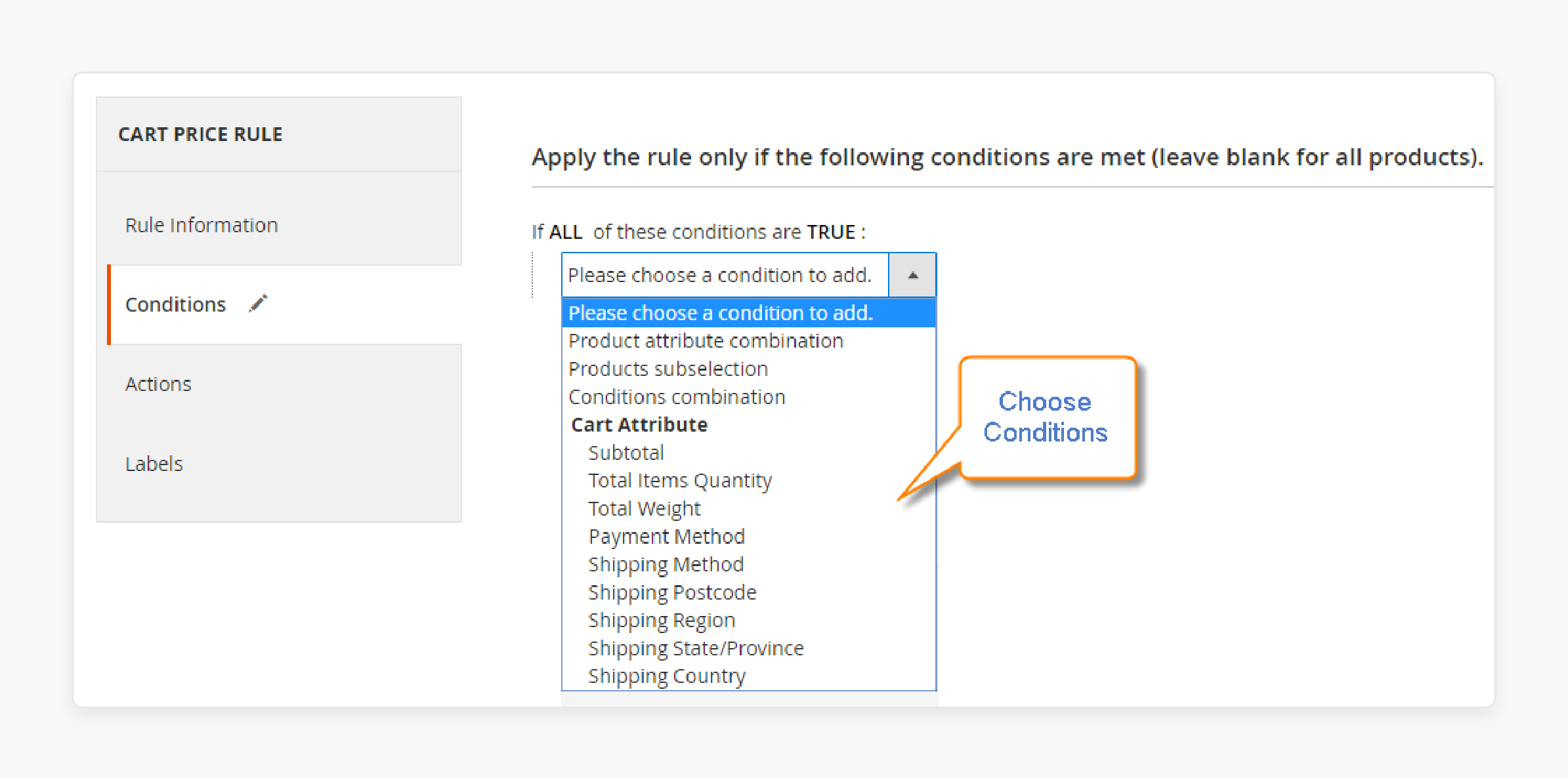
Customer Attribute Conditions
Customer data drives targeting:
-
Registration Date: Example: Target customers registered within 30 days.
-
Sale History: Example: Customers with lifetime orders of more than $500.
-
Geographic Location: Target specific states, cities, or ZIP codes.
-
Customer Groups: VIP, wholesale, and general classifications.
Cart Attribute Conditions
Shopping cart analysis creates behavioral triggers:
-
Subtotal Ranges: Example: $100-$200 for mid-tier campaigns.
-
Item Quantity: Example: Over 3 items for bulk discount eligibility.
-
Weight Thresholds: Heavy items trigger free shipping.
-
Product Mix: Items from many categories.
Advanced Condition Logic:
Customer Conditions:
- Customer Group = "VIP"
- Total Spent Lifetime ≥ $1000
Cart Conditions:
- Subtotal ≥ $200
- Total Items ≥ 3
Product Conditions:
- Category = "Premium Electronics" - Price ≥ $500
Product Attribute Conditions
Granular product targeting creates precise campaigns:
-
Category Hierarchies: Example: Electronics → Smartphones → iPhone.
-
Brand Targeting: Example: Nike, Adidas, Under Armour exclusions.
-
Custom Attributes: Color, size, material, season.
-
SKU Patterns: Bulk targeting using SKU prefixes.
Complex Condition Combinations
Boolean logic creates sophisticated targeting. The discount becomes active after accepted conditions:
IF (Customer Group = "VIP" AND Cart Total ≥ $300)
OR (Customer Group = "General" AND Cart Total ≥ $500)
OR (Product Category = "Clearance" AND Cart Items ≥ 5)
THEN Apply Promotion
Advanced Progressive Discount Strategy
-
Day 1: 5% off reminder email with product images.
-
Day 3: 10% off + free shipping with urgency messaging.
-
Day 7: 15% off + urgency timer showing limited availability.
-
Day 14: Last chance, 20% off with alternative product suggestions.
This sequence increases recovery rates compared to single-email approaches. Test various discount progressions to determine the optimal customer response rates.
Step 4: Define Actions and Discounts
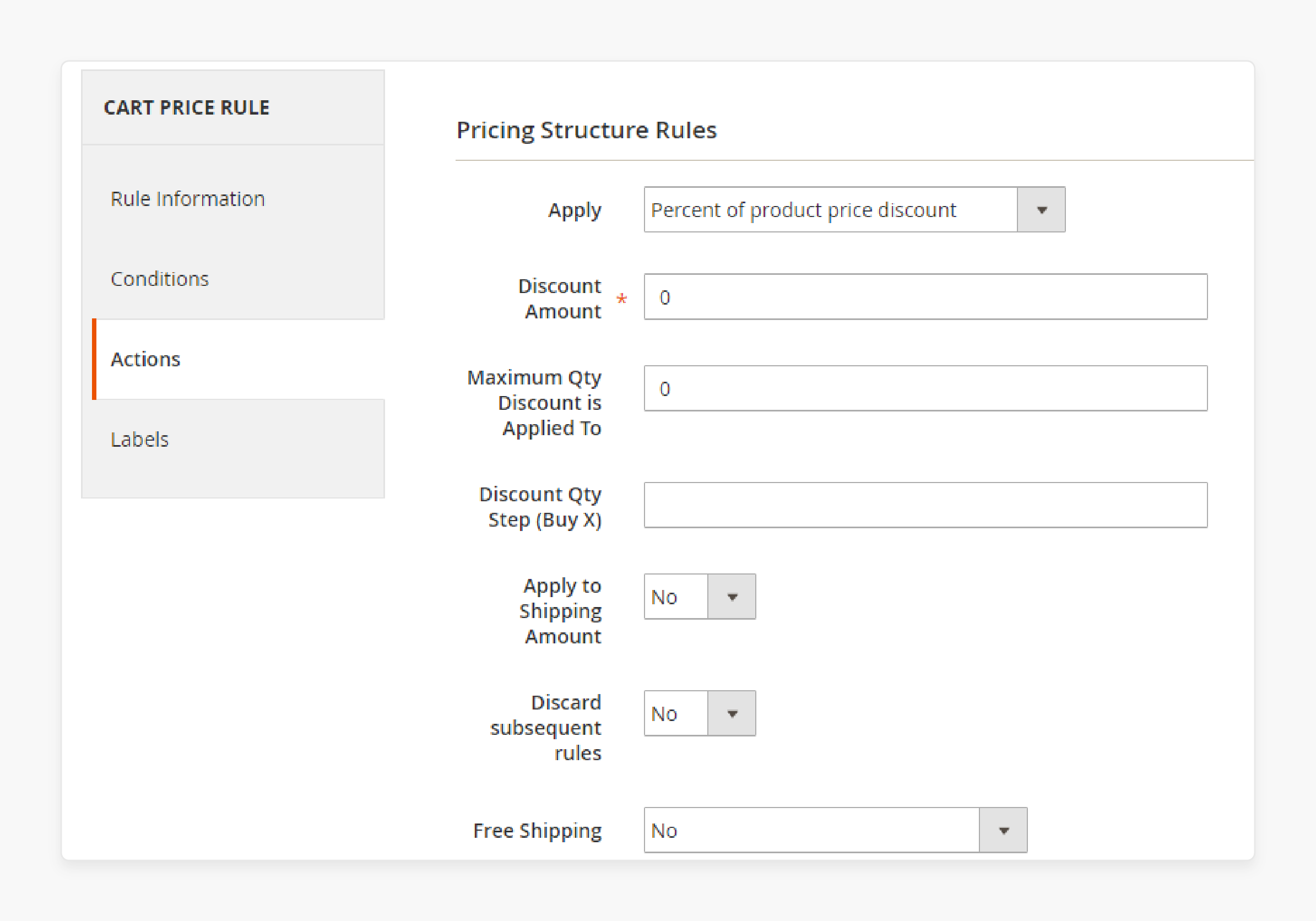
Discount Calculation Methods
The system offers different discount calculation approaches:
| Method | Calculation | Use Case |
|---|---|---|
| Percentage | Cart Total × Discount % | Maintain margin ratios |
| Fixed Amount | Cart Total - Fixed $ | Clear price points |
| Fixed Per Item | Item Count × Fixed $ | Volume incentives |
| Buy X Get Y | Conditional free items | Inventory movement |
Free Shipping Configuration
Free shipping discount integration requires coordination:
-
Method Selection: Standard, expedited, and overnight options.
-
Geographic Scope: Domestic, international, and regional limits.
-
Weight Restrictions: The greatest allowable weight for free shipping eligibility.
-
Value Thresholds: The least order requirements.
Advanced Action Parameters
Fine-tune Magento’s cart price rule behavior with advanced settings:
-
Discount Amount: Cap total savings per order.
-
Discount Qty Step: Apply discount every X items.
-
Apply to Shipping: Include/exclude shipping in the discount base.
-
Stop Further Rules: Prevent extra rule processing.
Action Configuration Example:
Discount Type: Percentage
Discount Amount: 20%
Discount Cap: $500
Apply to Shipping: No
Free Shipping: For orders ≥$200
Stop Processing: Yes (prevent stacking)
Step 5: Integrate Coupon Codes (Optional)
Coupon Generation Strategies
Coupon code creation balances usability with security:
Auto-Generated Codes:
-
Length: Example: 8-12 characters for memorability.
-
Character Set: Alphanumeric excluding confusing characters (0, O, I, 1).
-
Prefix/Suffix: Brand identifiers for recognition.
-
Pattern: Example: SAVE20-XXXX-XXXX format.
Custom Code Creation:
-
Brand Alignment: Coupon codes matching campaign themes.
-
Memorable Phrases: Example: WELCOME2024, FREESHIP50.
-
Social Sharing: Easy-to-share campaign coupon codes.
-
Tracking Integration: UTM parameter coordination.
Usage Control Mechanisms
Prevent abuse while supporting legitimate use:
-
Per-Customer Limits: Example: One use per customer email.
-
Total Usage Caps: Example: 1000 total redemptions.
-
Time Restrictions: Valid only during the campaign period.
-
IP Monitoring: Detect suspicious usage patterns.
Step 6: Include AI-Powered Dynamic Pricing
AI processes millions of data points to determine optimal discount timing and amount. Integration requires technical expertise, but it also improves promotional ROI.
Integrate with Adobe Sensei:
-
Predictive customer segmentation based on purchase patterns and browsing behavior.
-
Automated discount optimization that adjusts percentages based on conversion probability.
-
Real-time rule adjustments respond to competitor pricing and inventory levels.
Connect to Third-party ML Solutions:
-
Dynamic Yield integration for personalized product recommendations and pricing.
-
Optimized recommendations engine for A/B testing promotional strategies.
FAQs
1. Why is my Magento cart price rule not working?
Your rule might fail due to unmet conditions and low priority for the price rule. It might also be ineffective due to conflicts with other rules. Check conditions, priority, and status.
2. How to fix Magento cart price rules not applying?
Ensure the rule is active, coherent with conditions, and the discount applies. Verify it targets the whole cart or specific items in the shopping cart and adjust priority.
3. Can I combine Magento 2’s cart price rules with catalog rules?
Yes, use Magento shopping catalog price rules with cart rules. Set their priority to avoid clashes. Catalog rules apply first, then cart price rules adjust the cart total.
4. Do Magento cart price rules slow down my store?
Complex shopping cart rules can slow checkout. Simplify conditions and limit active rules to boost speed. Test performance after you add new rules.
5. What are unique marketing ideas for Magento’s cart price rules?
Offer flash sales, tiered discounts, or recovery deals with cart price rules. Use the percentage of the original price or bundle products in the cart for creativity.
6. How to set up cart price rules for customer groups in Magento 2?
If you want to create a cart price rule, add a 'Customer Groups' condition. This targets VIPs or wholesalers with exclusive discounts for the whole cart.
7. Which extensions enhance Magento’s cart price rules?
Extensions like Amasty or Mageplaza improve new cart price rule features. Add advanced conditions, scheduling, or reports to make price rules more powerful.
Summary
Magento 2 Cart Price Rules transform basic discounts into intelligent systems. Conditional logic processes customer data during checkout for personalization. Priority-based management prevents conflicts while allowing sophisticated campaign stacking.
-
Conditional logic combines customer, cart, and product data for precise targeting.
-
Real-time processing evaluates rules during checkout without performance impact.
-
Priority queue systems manage many active rules by assigning a number to each.
-
Strategic layering prevents conflicts and increases revenue potential.
-
Behavioral triggers recover abandoned carts through progressive discount sequences.
Want to maximize promotional effectiveness? Consider Magento managed hosting for expert rule implementation.



